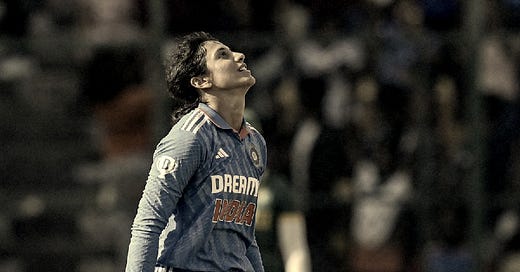The Elegance of Smriti Mandhana
This is the fifth in the series of Vijay Prashad's monthly column on cricket, Leg Glance, which appears in Deshabhimani Weekly in Kerala.
It was a surprise to me to learn that Smriti Mandhana, who opens the batting for India’s women’s cricket team and is the team captain, is right-handed. She bats left-handed, which gives her the natural advantage to drive the ball towards the covers. Her side-on stance and her balanced posture allow Mandhana to take her time, assess the length of the ball, rock back or move forward, and execute her shots with the best of timing. There are a few batters out there – men or women – whose style is fluency and grace, not a hint of hesitation and timidity. It is a pleasure to watch Mandhana face the fastest of bowling, her high back lift allowing her the time to decide how she wants to middle the ball gently and push it past the boundary.
I suspect she will not forget her One Day International (ODI) innings of 15 January 2025 against Ireland in Gujarat. Ireland is not one of the strongest teams, but it does have some inventive bowlers. Orla Prendergast, for instance, bowls inswing to the right-handed, but has been able recently to move the bowl both ways. Mandhana went in with Pratika Rawal, who has shone as Mandhana’s partner at the top of the order with as much elegance as her captain. By the time Mandhana was out in the 27th over to an average delivery by Prendergast, the two openers had put on 233 runs, with Mandhana contributing 135 of them. What was remarkable about Mandhana’s innings was that she got to her hundred in seventy balls, the fastest for Indian women in ODIs, and that Mandhana and Rawal scored their 200 runs at a rate of 8.73 runs per over (the fastest in any women’s ODI). The two openers broke a series of records with their stand, which broke the will of the Irish players who lost by 304 runs by the end of the day.
Bear in mind that Mandhana made her international cricket debut in 2013 at the age of sixteen. But when she was younger than that, and when she got inspired to play cricket, she was taken by the Indian opener Krishnamachari Srikkanth, who played international cricket from 1981 to 1992. Mandhana watched this tornado of a batsman on YouTube and took inspiration from his remarkable style. Srikkanth had a carefree attitude at the crease, inspired by his love for the sport and his fearlessness for the fastest of bowling. At the age of 21, Srikkanth made his ODI debut against England in 1981, opening the batting with the far more conventional Sunil Gavaskar at the other end. What a treat it must have been for Gavaskar to watch his partner come out swinging from the first ball, anticipating the style of the T20 cricket players of our day. At the World Cup final in 1983 that India won, Srikkanth didn’t seem to care that he was facing the fastest bowling attack the West Indies had mustered, with Andy Roberts, Joel Garner, Malcolm Marshall, and Michael Holding at their peak. He went after the bowling to score 38 runs off 57 balls (7 fours and 1 six), Gavaskar having got out for 2 in 12 balls. It makes sense that Mandhana, who bats with equal elan, was inspired by Srikkanth (although she also says that she watched two other batsmen, Sourav Ganguly and Matthew Hayden, both right-handers who batted left-handed).
Sometimes Srikkanth appeared erratic, going for a pull shot against a ball that was good length and coming in too low. But he would somehow connect and send the ball flying into the stands. That is not Mandhana's approach, whose signature shot is her cover drive. In that remarkable game against Ireland, when Prendergast or Ava Canning missed their length, Mandhana would lean into the ball, meet it as it comes to her, and with her elbow high and her eyes sharply on the ball, guide it into the covers with what appears to be just a very gentle push. ‘I am a batter who likes to time the ball’, she says. ‘I don’t go for power hitting. If I try to hit the ball very hard, I lose my shape and even a ball that could have been timed well for a four or six, that ball can also get me out’.
The cover drive is often thought of as the most elegant shot in the repertoire of the batter. It is pleasing to the eye because of the economy and efficiency of the stroke. The two words ‘economy’ and ‘efficiency’ are frequently used to explain the delight of the perfect cover drive. There is a reason for this. If the purpose is to get the ball to the boundary, then there is nothing as delightful as a cover drive that is timed to perfection; the ball, struck at the perfect moment, glides off the face of the bat and dances across the grass to the boundary line. When a batter knows that they have accomplished this task, they can hold their pose, the bat in the air, triumphant.
I can’t for the life of me understand why there is such a marked distinction between the viewership of men’s and women’s cricket. The quality of the latter is by far as good as the former, and few batters are as wonderful to watch, even in the men’s game, as Mandhana. That there remains a pay gap reflects the inadequacy of society, not merely of the cricket industry. But why there are not more spectators for the women’s side and no more test matches for women frustrates me greatly. I would like to see Mandana and Rawal go out there and bat their way to glory in test after test. What they accomplished in the ODI against Ireland is an amuse-bouche. What they could accomplish in a test match would be so much more. Sexism furnishes its own boycott, disallowing women to play as many matches as men.




